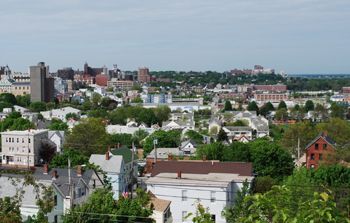Architects urge developers to consider rising sea levels
 Photo/Rebecca Goldfine
A look at Portland's Bayside neighborhood, which architects say could be affected by rising sea levels in the future
Photo/Rebecca Goldfine
A look at Portland's Bayside neighborhood, which architects say could be affected by rising sea levels in the future
A three-and-a-half-foot rise in the sea level here would, if propelled by a storm surge, swamp large portions of Commercial Street and the Marginal Way-Bayside area, a prominent focus of recent redevelopment efforts.
This scenario will be an increasing possibility in the next 50 to 100 years as warming ocean temperatures, melting polar ice and changing weather patterns cause greater coastal flooding, according to scientists. To grapple with the threat of these looming deluges, a group of local architects is sounding alarm bells about the need to design buildings with a very different future environment in mind.
"Whether or not you think this is due to global warming, and whether or not you think global warming is caused by our footprint, it is happening," says Paul Stevens, principal at the Portland architecture firm SMRT and president of the nonprofit Portland Society of Architects. "The sea level is rising and it appears it will continue to do so. Projections keep inching upwards rather than in the other direction. Whatever caused it is not worth arguing about."
Storms that bring on large destructive waves are also worsening, he adds. "Twenty-year storms are happening in five-year frequencies. In addition to sea-level rise, this creates quite a good deal of risk."
The Portland Society of Architects in mid-May organized a conference in Portland on rising sea levels. The event covered how the city might mitigate the effects of higher tides and storm surges, as well as the economic, infrastructure and policy issues the city could eventually face. Many architects and planners attended the conference, Stevens says, but only one city councilman showed up, and no members of the business community attended.
"There are an awful lot of people who aren't so much skeptical as like, ‘Don't bother me about that right now,'" he says.
The conference came a few days before a city committee approved selling a 3.25-acre parcel in the low-lying Bayside area to a Boston- and Miami-based developer who plans to build apartments, offices and retail stores there. The Federated Cos., which last December bought a nearby student apartment building for about $9 million, is planning to purchase several contiguous lots along Somerset and Elm streets for $2.3 million, and spend "well in excess of $30 million" to develop them, according to Jonathan Cox, founder of The Federated Cos. The city council will take up the sale agreement next month.
Cox says he's aware of the talks that have taken place around rising ocean levels. "We're conscious of those discussions and it is something that is considered in the planning phase. But how much weight it has -- it is not one our priorities," he says. His priorities are to develop a building that's consistent with objectives held by his company, the city and the community, he says.
Portland's economic development director, Greg Mitchell, says the new project, if approved, will help further the ongoing revitalization of the former industrial area, which in the past four years has seen the addition of a bike path, Whole Foods, Trader Joe's and other developments. "I think [The Federated Cos.' project] is fabulous from a standpoint of injecting hundreds of [apartment] units and hundreds of people, and the spending associated with that, into the neighborhood so it will grow and redevelop," Mitchell says. The preliminary plans include a 500-car garage in a former scrap yard and a multi-use building that will likely have retail space on the first floor, parking above, and apartments on the upper floors.
In some ways this plan almost fits Stevens' and other architects' suggestions for flood-proof development. To protect people and property from storm surges, Stevens recommends raising buildings and putting parking on the ground floors, which is Intermed did with its new office building, also in Bayside on Marginal Way. "That's the only structure down there that's in good shape," Stevens says.
Many European cities have already put in place infrastructure to mitigate flood damage, such as building sea walls and berms, Stevens says. Cities can also ensure that all new buildings are hoisted one level above the street, and encourage floating real estate on the waterfront, something along the lines of DiMillo's restaurant in Portland, according to Stevens.
Ed Suslovic, the city councilman who attended the conference, says he thinks it makes sense from an economic policy position to begin thinking about these problems now, despite it being a far-off problem. "By raising the issue of sea level now and ways to respond to it, we're not in a panic situation," he says. "We have the time to study it."
And he says that a reasonable approach to the issue could boost Portland's appeal. "Responding to sea-level rise will not scare people away, but will make Portland, if we can get ahead of this, more attractive to developers," he says. "We can say, if you invest in our city, we will take the risks away from rising sea levels."
Meanwhile, Stevens says the Portland Society of Architects is going to continue to raise awareness about the issue not only with public policy makers, developers and Realtors, but with its own members as well.
"As responsible designers, architects have to have those conversations with their clients," Stevens says, when they are considering building near the shore. "Sometimes we will be heeded; and other times the outlook on a property might be more short-term and we might not be heeded."










Comments